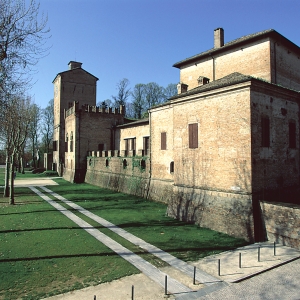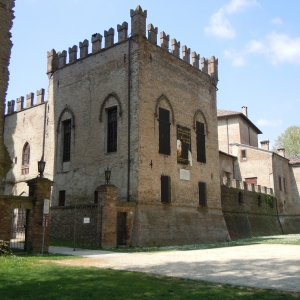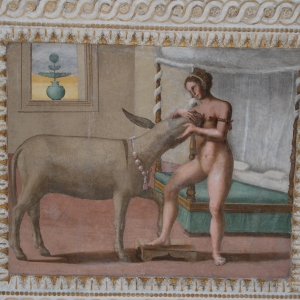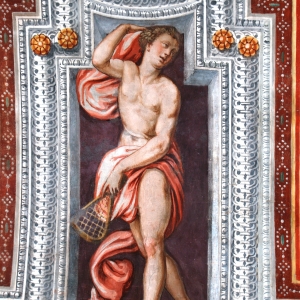Of the ancient entrance to the castle, located to the south of the donjon, only the arch with the first of the three arches that originally opened onto the bridge that spanned the moat is preserved.
Once incorporated into the structure by the salt block that surrounded it, demolished in the 19th century, stands alone the ancient donjon, connected to the structure by a simple entrance gate. Equipped with a tower with a clock, secret passages leading outside the manor started from the basement, now walled up. The
fortress was built on a hillock around 1413 at the behest of Pier Maria I de' Rossi, father of Pier Maria II, to defend the fortified village of San Secondo, over which the Rossi family had claimed rights since the 12th century and exercised lordship as counts from 1365.
read more
In the 16th century, the castle was transformed from a defensive fortress into a sumptuous residence. The lineage reached the height of its splendour towards the middle of the century. In 1817, the last Count of the Rossi family, Gian Girolamo, left the usufruct of the Rocca to his brother Guido and named Count Ferdinando Vaini as sole heir. In
1825, on Guido's death, the entire property passed to the Vaini family who, unable to cover the running
costs, sold the furnishings and demolished a large area of the manor house. Despite this loss, the most beautiful part of the castle can still be visited today.
The Hall of the Red Deeds is the most important and majestic in the castle. A
masterpiece of 1200 square metres of frescoes by some of the most important artists of the time (Cesare Baglione, Orazio Samacchini, Ercole Pio, Bertoja). A succession of grotesques and allegories, interrupted by 13 large-scale fresco paintings depicting as many episodes that were fundamental to the Rossi family, starting from 1199 and ending in 1542.
The Sala dell'Asino d'Oro (Golden Donkey Room), one of the oldest in the castle (dated between 1528 and 1532), is an undisputed jewel that has been excellently preserved. It
was once the bridal chamber and is dominated in the ceiling by 17 paintings from Apuleius' 'The Metamorphoses', with a focus on the story of 'Lucius the donkey', without any reference to 'Cupid and Psyche', a fable generally dear to Renaissance artists. This choice makes the fresco ununicum in its genre.
The Aesop Gallery, with its array of fables inspired by the ancient Greek writer, is one of the richest dedicated to this genre. Among the best-known stories represented: The Wolf and the Lamb, The Fox and the Lion, The Fox and the Mask.
shorten







